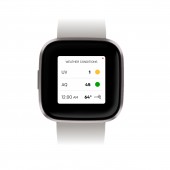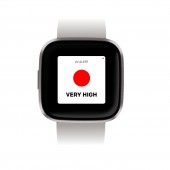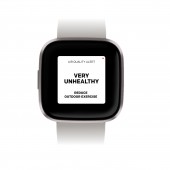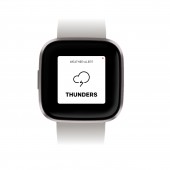
| THE AWARD |
| CATEGORIES |
| REGISTRATION |
| SUBMIT YOUR WORK |
| ENTRY INSTRUCTIONS |
| TERMS & CONDITIONS |
| PUBLICATIONS |
| DATES & FEES |
| METHODOLOGY |
| CONTACT |
| WINNERS |
| PRESS ROOM |
| GET INVOLVED |
| DESIGN PRIZE |
| DESIGN STORE |
| THE AWARD | JURY | CATEGORIES | REGISTRATION | PRESS | WINNERS | PUBLICATIONS | ENTRY INSTRUCTIONS |
Ttmm-S For Fitbit Versa App by Albert Salamon |
Home > Winners > Design #97560 >Interview |
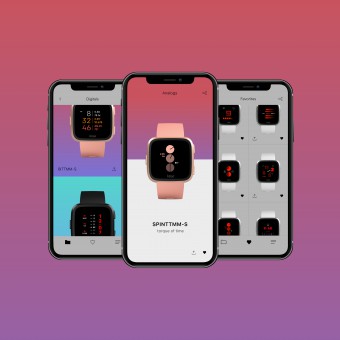 |
|
FS: What is the main principle, idea and inspiration behind your design?
AS: Minimalism, simplicity, purism, hence the lack of unnecessary graphic elements is the mark of TTMM brand. This is also the way to increases the legibility of the presented information, which is also our prerequisite. This collection includes clear and functional designs as well as eccentric ones that require some guidance for the user at the start. These completely new formal solutions require some effort in deciphering the riddle of time perception. They also spark a reflection on time itself, developing the overall human sensitivity. I feel that this approach is unpopular nowadays, yet it establishes the TTMM audience as very exceptional, as people who see things in a different way.
FS: What has been your main focus in designing this work? Especially what did you want to achieve?
AS: The project combines 3 important values: 1. the TTMM brand – offering award-winning time face designs, 2. advanced weather features, 3. a convenient application in a subscription model, divided into categories, with user guidelines and a list of favorites including a quick option to upload designs and a search engine for additional design features. This personal collection, with its originality and functionality, easily competes with watch apps offered by Fitbit or Apple. The TTMM-S application brings selection, order and moderation of the abundance of designs – a clear advantage over overloaded app marketplaces. The most important feature of the TTMM-S app is the Weather Alert, that warns of hazardous air pollution or UV radiation in the vicinity. TTMM-S clock faces are equipped with three types of alerts: dangerous weather conditions, very high UV radiation, or unhealthy air quality. When the outside conditions turn unhealthy or dangerous, the clock face will make the smartwatch vibrate and display a warning message.
FS: What are your future plans for this award winning design?
AS: I plan to develop it on Fitbit and / or other similar platforms. And in the future, I'd love to build my own hardware product to go with the software that I make today.
FS: How long did it take you to design this particular concept?
AS: It took me almost 1 year, working extensively, supported by a team of programmers.
FS: Why did you design this particular concept? Was this design commissioned or did you decide to pursuit an inspiration?
AS: This collection was created as a selection of the best TTMM designs created over the years. I have experimented with various forms of clock-face design from very clear and functional to very abstract and artistic. Observing my clients' choices, I made selections and improvements. Today, the latest collection with 66 clock faces has been reduced to the top 12.
FS: Is your design being produced or used by another company, or do you plan to sell or lease the production rights or do you intent to produce your work yourself?
AS: TTMM-S for Fitbit Versa is a software product dedicated only to Fitbit Versa smartwatches. I would love to create my own hardware product which will be a "work in time" and will serve people. I am also thinking of a product with high standards of privacy, where the data belongs to the user only. Such a product is anti-commercial and requires a wise and humane investor. I would love to meet one like that.
FS: What made you design this particular type of work?
AS: Two huge and important problems - lack of good clock faces projects and bad clock face galley store. HYPERATTRACTIVE! Most clock faces are made by programmers for whom the meaning, sense, visual value and form of the project are in the background (because they are not educated designers). They compete in the coolness and attractiveness of the offered products in order to attract the attention of recipients and sell as much as possible, e.g. they add animations that do not improve the quality of the project but are an attractor function. I decided to design a beautiful, characteristic, useful and comfortable collection. TTMM watches are balanced, calm and modest. EXCESS, SHIPPING, REJECTION! Today, a huge problem is the overproduction of clock faces and other digital products (applications, movies and music). Proper organization and presentation in the clock face gallery is necessary to see and understand the nature of the projects, so as not to overdo the recipient and discourage with excess. Today, the native Fitbit app presents a stream of thousands of clock faces crammed together. Reviewing 5,000 projects is a waste of human life and is a contradiction to caring for human health. In my opinion, it causes stress and discouragement. My answer is a separate TTMM-S application containing a collection of well-designed and presented clock faces. The TTMM-S application addresses the problem of organization, search, presentation and the list of favorites, which enables the optimal use of the necessary projects. The TTMM-S application also solves the big UX problem of the original Fitbit application in which it takes many clicks to find what you are looking for or to upload a clock face. I made the TTMM-S application for myself to save myself time. I believe that this is a human approach and it is good for business.
FS: Where there any other designs and/or designers that helped the influence the design of your work?
AS: The inspiration for the collection comes from three different areas: sci-fi movies, electronic music, and the idea behind Tokyo Flash Japan. The movies that inspired me about the weather issues are: The Day After Tomorrow, Waterworld, and Hbo’s Chernobyl mini-series, and the music that influenced me during my work was the album Radioactivity by Kraftwerk.
FS: Who is the target customer for his design?
AS: TTMM’s abstract designs are more than just a display of time – they are “digital jewelry” that the user can host on the device and adjust to their look, mood, or to the occasion. These “faces of time” also bring a reflection on the passing of time. This set of values distinguishes TTMM projects from the competition and allows to build a loyal group of users. So the recipient thinks about what he is looking at, asks himself questions, feels and experiences, has a reflection on time - and has time for it.
FS: What sets this design apart from other similar or resembling concepts?
AS: There are several points of difference: 1. design quality with rich user experience 2. weather views and alerts are a unique feature on the market 3. highly specialized functions and well designed exceeding the standard offering of Fitbit and iWatch 4. the subscription model is also one of the kind 5. the brand and products with several design awards
FS: How did you come up with the name for this design? What does it mean?
AS: Brand name TTMM - is the genotype for all TTMM products. TTMM is a composition of a decomposition of time: TIME – a word and a HH:MM code. The name mechanical pronunciation represents the progressive digitalization of our times. TTMM logo is built on overlapping T and M letters. It expresses the explosion of meaning in time. Kind of tree or a processor of time. In TTMM-S the "S" suffix stands for the subscription model of purchase.
FS: Which design tools did you use when you were working on this project?
AS: I have been working on the SKETCH program for a year. This is a great tool for designing multi-view interfaces. It not only allows to quickly design and prepare documentation for programmers, but also to prepare all the necessary production and promotional and advertising assets. It is just epic!
FS: What is the most unique aspect of your design?
AS: TTMM-S is a contributor to our visual culture with a bold new way of thinking about face time design. TTMM-S is reaching beyond trends in shaping the perception of time. Moreover the weather alerts – especially those concerning the quality of the air – address the climate change problem and the effect it has on peoples’ lives. Today, in the era of COVID-19 infections, some studies show the relationship between the possibility of increased infections and polluted air. If TTMM-S products could help minimize this factor, it would be a very important thing for me if it happened.
FS: Who did you collaborate with for this design? Did you work with people with technical / specialized skills?
AS: In the project, I used my own - unique, accumulated through many years of experience in the analysis and creation of watch faces micro-interfaces for smartwatch screens. This experience covers many fields: user interface design, user experience design, graphic design and branding. I am one of the few designers in the world who have received so many international awards including the Red Dot. I recognize my position as an expert. The UX design of the TTMM-S application was designed by Leszek Juraszczyk, responsible for an orderly and clear presentation of various watch application designs. Marcin Berendt advised me in the field of brand strategy and product marketing. The following programmers also participated in the project: iOS: Rafał Gorczyński and Arkadiusz Banaś. Fitbit programming: Piotr Kamiński, Wiktor Hołubowicz and Gregoire Sage.
FS: What is the role of technology in this particular design?
AS: Projects created today use a multitude of technologies that have to meet each other, talk to each other and cooperate seamlessly. Finally, the software meets the hardware and the hardware meets the user, as there is a smartwatch on the user's hand displaying information, which is used by the user to make everyday decisions. In case of weather - this information is taken from specialized weather services, which display precise information about the presence of harmful particles in the air and, if necessary, alert the user to take care of his health based on his current location. This process happens underneath the "watch face". It is amazing what one can do with the available technology nowadays. It can surely say that technology is the essence of TTMM products.
FS: Is your design influenced by data or analytical research in any way? What kind of research did you conduct for making this design?
AS: Our planet’s climate is changing. Weather services and sensors technologies provide a lot of information about the quality of the weather, air pollution, and ultraviolet radiation. A smartwatch is a great place to inform us about the weather or warn us about threats, e.g. excessive UV, dangerous air quality, or weather events. Organizing and providing this information in clear views will help us live better and prepare for the future. Because I did not find any clock face applications that would combine good modern design and information about air quality and weather alerts, I decided to design such an application for myself and make it available as a product.
FS: What are some of the challenges you faced during the design/realization of your concept?
AS: The application had 3 challenges: 1. to redesign and add to existing very graphic designs, a presentation of weather information (temperature and icons), and to design legible views with weather and weather alerts. 2. to design a modern application layout that will allow space for all necessary information about the operation and settings of clock faces and will have a simple yet unique interface. 3. to propose an affordable financial purchase model. The TTMM-S app is the only app on the clock face market for Fitbit Versa smartwatches, which offers a monthly subscription plan (for just 1.99$). This solution covers the monthly cost of weather services and allows users to pay for the application only for the time they want to use it.
FS: How did you decide to submit your design to an international design competition?
AS: TTMM projects are ahead of their time and a good way to check and confirm this, is by participating in design competitions. For years, I have been submitting TTMM designs to the professional jury's evaluation, and the A Design Award is one of my choices.
FS: What did you learn or how did you improve yourself during the designing of this work?
AS: I am learning transparency in communicating feature-rich TTMM projects. This requires discipline, synthesis, simplifications and a balanced selection of descriptions and graphics for presentation to facilitate the concept and use of TTMM designs.
FS: Any other things you would like to cover that have not been covered in these questions?
AS: I believe that the role of competitions such as the A Design Award is not only to select, reward and promote the best projects, but also to notice, highlight and promote innovative and culturally and environmentally important projects. I consider TTMM to be such. Today, the excess of awarded projects makes them irrelevant to each other and increases the information buzz.
FS: Thank you for providing us with this opportunity to interview you.
A' Design Award and Competitions grants rights to press members and bloggers to use parts of this interview. This interview is provided as it is; DesignPRWire and A' Design Award and Competitions cannot be held responsible for the answers given by participating designers.
| SOCIAL |
| + Add to Likes / Favorites | Send to My Email | Comment | View Press-Release | Translations |
